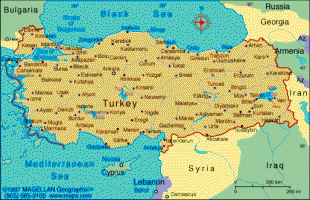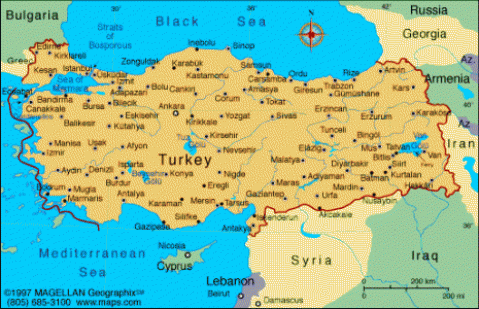Widgetized Section
Go to Admin » Appearance » Widgets » and move Gabfire Widget: Social into that MastheadOverlay zone
Regional Development Agencies: An Innovative Development Management Model in Turkey
By Dr. Mehmet Yesilbas, PhD, MPA, LL.B
The new models and approaches emerging within public administration are focused on effectiveness and efficiency. The main functions of such approaches include quick decision-making and effective troubleshooting. Within this context, the necessity to struggle with the problem of development and to develop enduring policies has appeared.
 In addition, the units organized aside from the central administration with more competence and responsibility and to change the traditional structure of the competence-resource range between the central and local administrations has also emerged. This has been especially common with the proliferation of democratic culture, changes in the increase in welfare and population resulting in differences in terms of necessities and expectancies. As a natural consequence new structures set forth in order to fulfill the local common necessities have become so noteworthy that Regional Development Agencies (RDAs) have developed as the institutions created to satisfy such a need.
In addition, the units organized aside from the central administration with more competence and responsibility and to change the traditional structure of the competence-resource range between the central and local administrations has also emerged. This has been especially common with the proliferation of democratic culture, changes in the increase in welfare and population resulting in differences in terms of necessities and expectancies. As a natural consequence new structures set forth in order to fulfill the local common necessities have become so noteworthy that Regional Development Agencies (RDAs) have developed as the institutions created to satisfy such a need.
There are many Regional Development Agencies operating at national or transnational level in Europe. According to D. Gibbs, in a 2000 study entitled Ecological Modernization, Regional Economic Development and Regional Development Agencies, these development agencies have different structure, characteristic and status. The majority of these agencies have been established in the heart of the Europe. For example, the top organization, the European Association of Development Agencies (EURADA) is based in Brussels. According to 2012 EURADA records, there are approximately 130 regional development agencies all over the Europe. Ward, Lowe and Bridges, as specified in their study in 2003 Rural and Regional Development: The Role of the Regional Development Agencies in England, state that these agencies have been operating since 1950. Regional development policies were restructured in the last quarter of the twentieth century, regional policies in Europe seem to have received a different aspect.
Turkey today faces obligations to reconsider its policies and eliminate the imbalances between regional development policies. The  essential reason for this is that regional development policies were not integrated into the negotiation process of the European Union. Thus, Turkey entered a reconstruction process by abandoning the central regional development model, policy and tools that it has been using for 40 years. The units called Regional Development Agencies (RDAs) constitute the main element of this structure. As a consequence of this improvement a new development process has been started in Turkey. In February 2006, the Turkish Parliament passed legislation to promote economic growth through a system of RDAs.
essential reason for this is that regional development policies were not integrated into the negotiation process of the European Union. Thus, Turkey entered a reconstruction process by abandoning the central regional development model, policy and tools that it has been using for 40 years. The units called Regional Development Agencies (RDAs) constitute the main element of this structure. As a consequence of this improvement a new development process has been started in Turkey. In February 2006, the Turkish Parliament passed legislation to promote economic growth through a system of RDAs.
Establishing the RDAs in Turkey is related to the idea that size and spending of the state is too large to establish an effective and efficient development system. Most thinkers have stated that methods and principles of the private sector should be implemented in public sector. Departments of government should undertake smaller structures instead of classic bureaucratic ones because bureaucrats do not have any motivation to be effective, efficient and productive. Rather, they only try to increase their budget, size and authority in Turkey. The objectives of the RDAs are to distribute budget funds to local stakeholders and to improve the efficiency, effectiveness, accountability and productivity of government. In order to achieve these objectives, market-type mechanisms such as privatization and competitive tendering has been introduced in the public sector.
According to a 2002 Thiel and Leeuw article in Public Performance& Management Review entitled “The Performance Paradox in the Public Sector” some departmental units of government have been hived off into quasi-autonomous nongovernmental organizations and private sector organizations in Turkey.
Young-Hyman, as stated in his 2008 article The Potential for Effective Regional Development Agencies in Turkey: A Comparative Analysis, emphasized that the new legislation signaled an attempt by of the administration to shift development strategies. The goal is to move away from traditional sector-based, centrally driven Turkish national policies by adopting a European development model and attempting to emphasize sub-national regions as engines of economic growth.
Considering the highly centralized state tradition and the low level of socio-economic development in many parts of Turkey, the adoption of a development strategy often associated with advanced industrialized countries and strong regions has caused some analysts to view “regionalization” as a policy that has been superficially applied for EU candidacy purposes and cannot be effective. At the core of this argument is the idea that there is a contradiction between the idea of regional development in the European sense and the reality in Turkey. Accordingly, Young-Hyman in his 2008 study reported that effective regional development policy in contemporary Turkey is simply impossible because the necessary civic and economic resources are not present. The passing of the RDA law in Turkey presents an opportunity to challenge that analysis.
Regional development agencies are institutions established as a structure independent from the central government of Turkey. The main purpose of establishing regional development agencies in Turkey is to implement regional strategies, to support regional and nation-wide enterprises, to examine local and regional solution for the near future of private sectors, to search new financial guaranties and solutions to the demand for new products and services. The most innovative way of the RDAs is that there are not only central government’s representatives, but also local actors in the decision-making mechanism. The central governments’ representatives in the regional area started to share public authority with the local actors. The central development model in Turkey was implying that all development process should be managed by the central government, mainly the Ministry of Development. This model excluded local actors and stakeholders such as municipalities, province special administration, local chambers of commerce and industry and non-governmental organizations contrary to the new model providing a more collaborative, democratic and effective system.
Dr. Yesilbas is District Governor and Attorney at Law as well as Deputy Head of EU Affairs & Foreign Relations Department in the Turkish Interior Ministry in Ankara, Turkey. E-mail: [email protected]






 (62 votes, average: 4.58 out of 5)
(62 votes, average: 4.58 out of 5)
Davut uluoz
September 25, 2013 at 4:07 am
Great article. It reviews Turkey’s transition from central development model to regional development model. There were a lot of dissucussion about these RDAs among policy makers and strategist in Turkey. I hope the transition will be smooth and the new model will bring wealth for Turkish people.
Akif KAPLAN
September 23, 2013 at 7:43 am
An explaining description about situation of RDAs in Turkey. It is an important subject in Turkey for last 4 years. Some RDAs are very succesfull some are not. Maybe next essay should be about effective management stragies of RDAs.
Rafi REFIK
September 18, 2013 at 2:01 pm
Great piece, it will be great if you can write its Turkish version too.
Mehmet Yesilbas
September 18, 2013 at 5:02 pm
You can check its Turkish version by visiting microsofttranslator website given below, although it is not a perfect translation.
http://www.microsofttranslator.com/bv.aspx?from=&to=tr&a=http%3a%2f%2fpatimes.org%2fregional-development-agencies-innovative-development-management-model-turkey%2f%23comments